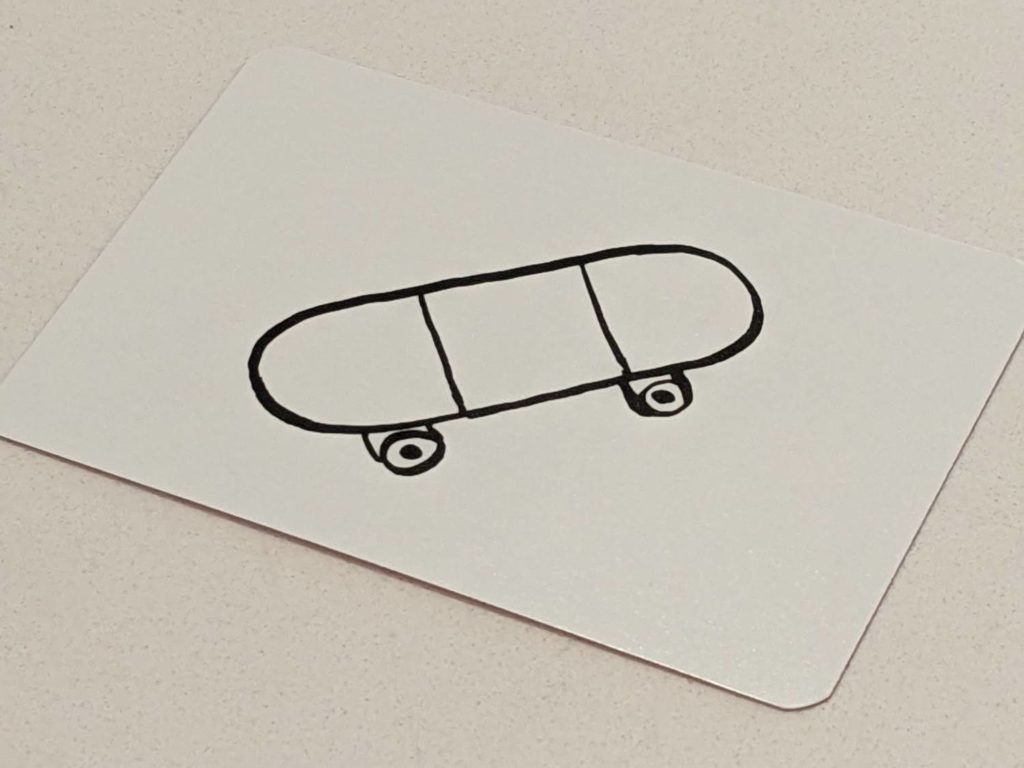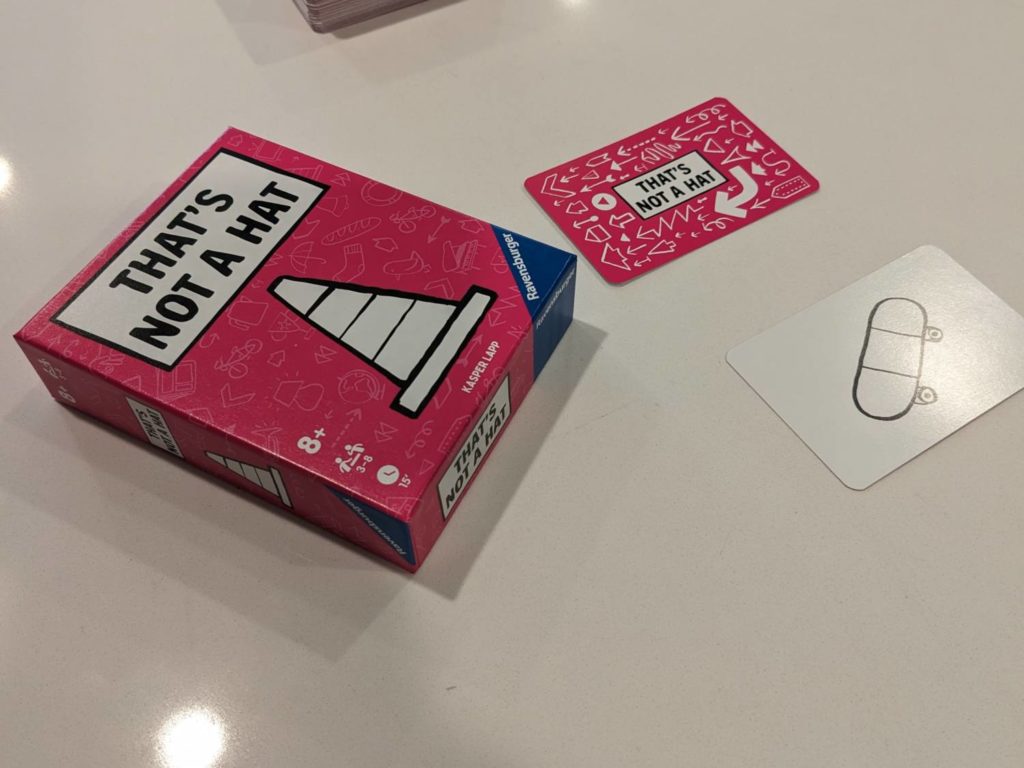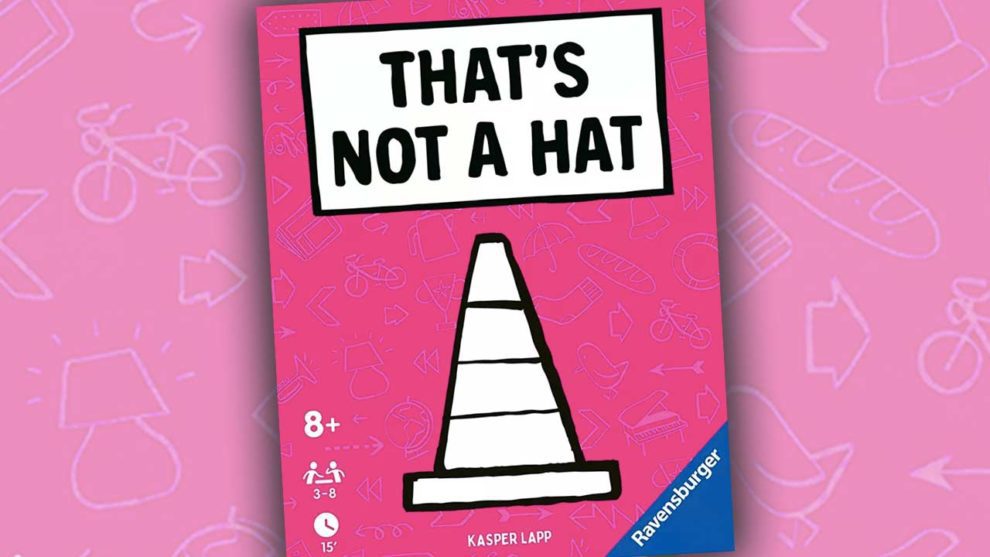“It’s like Memory, combined with scribbled pictures. Wanna try it?”
This was my intro to the kids to get them to try That’s Not a Hat (2023, Ravensburger) after a long week of car travel for spring break. My daughter will generally try anything, but games that feature pictures usually make her jump, so she was on board.
My son was a slightly tougher sell. “Is it cooperative?” he asked.
“No. We’ll each have a couple of cards in front of us, but the goal is to try and remember what everyone has in front of them. If you don’t, you’ll take on ‘penalty points’ and the person who has the most penalty points triggers the end of the game.”
My son turned skeptical. “I’ll play if it’s quick.” (Apparently, he had a hot date with the LEGO set perched nearby.)
That’s Not a Hat is, in fact, quick—10-20 minutes in most cases with three or four players. Longer than that, and then you have a different question to answer: is this a gift worth giving?

Bluff, Then Re-Gift
That’s Not a Hat is a bluffing game laced with elements of the game Memory for 3-8 players. To begin play, each player has a single card in front of them, featuring a simple, hand-drawn picture: a cooked egg, a football, a pair of dice.
The first player takes a card off the top of the face-up deck, announces what they have drawn, then they flip the card over to reveal a directional arrow. Passing this card to the left or right (based on the arrow), the giver then says to the receiving player “I have a nice _____ for you.” The giver can choose to either make something up to fill that blank, or pass it with the actual name of what is on the card. (Typically, on your first turn, you aren’t going to fool anyone with a bluff.)
Then the receiver can choose to either accept the gift—if they think the card really has what it says it has on its face—or refuse it, if they think the giver is bluffing. If they accept it, they don’t flip it over, but instead use that to replace their previous gift, which will then be used to play the next turn.
If they refuse the gift, the card is flipped, and whoever was wrong takes the card as a penalty point. A player that takes a penalty point begins the next turn by taking the top card off the deck to start the process again. When any player has three penalty points, the game ends and whoever has the fewest penalty points wins.

Right Down the Middle
That’s Not a Hat fits into a really tight window. I don’t know anyone who was craving a bluffing game with memorization elements, because there is literally zero hidden information in this game. All of the cards, at some point, are face-up, so a sharp player in a smaller player count game will likely know when they are about to be defrauded.
If players try to play this straight up—by only offering gifts that are what they say they are—there is almost nothing interesting to do except, wait, I guess? Wait until you are 6-7 cards deep and hoping to fool another player?
My six-year-old and nine-year-old kids never tried across multiple games to try and sneak one past me, but things do get interesting when other players can’t remember what card they supposedly have in front of them. (The only real wrinkle here is that players cannot look at their own face-down cards once they accept a gift.)
I was hoping to have a few more laughs with this one, but refusing a gift is meant to be the game’s shining star; that’s why the game is called That’s Not a Hat. In practice, saying “That’s not a scooter!”, “That’s not a pencil!”, and “That’s not a clothes hanger!” didn’t really get the juices flowing, although in one game, my son did storm off after taking a second consecutive penalty point, so his juices were really flowing.
This leaves That’s Not a Hat in the toughest of places for a game reviewer: the gameplay is fine, moments are never objectionable, it is certainly easy to teach, and is an average production. But after a few plays, That’s Not a Hat will not provide party game thrills with the likes of more reliable games in my collection.












Add Comment